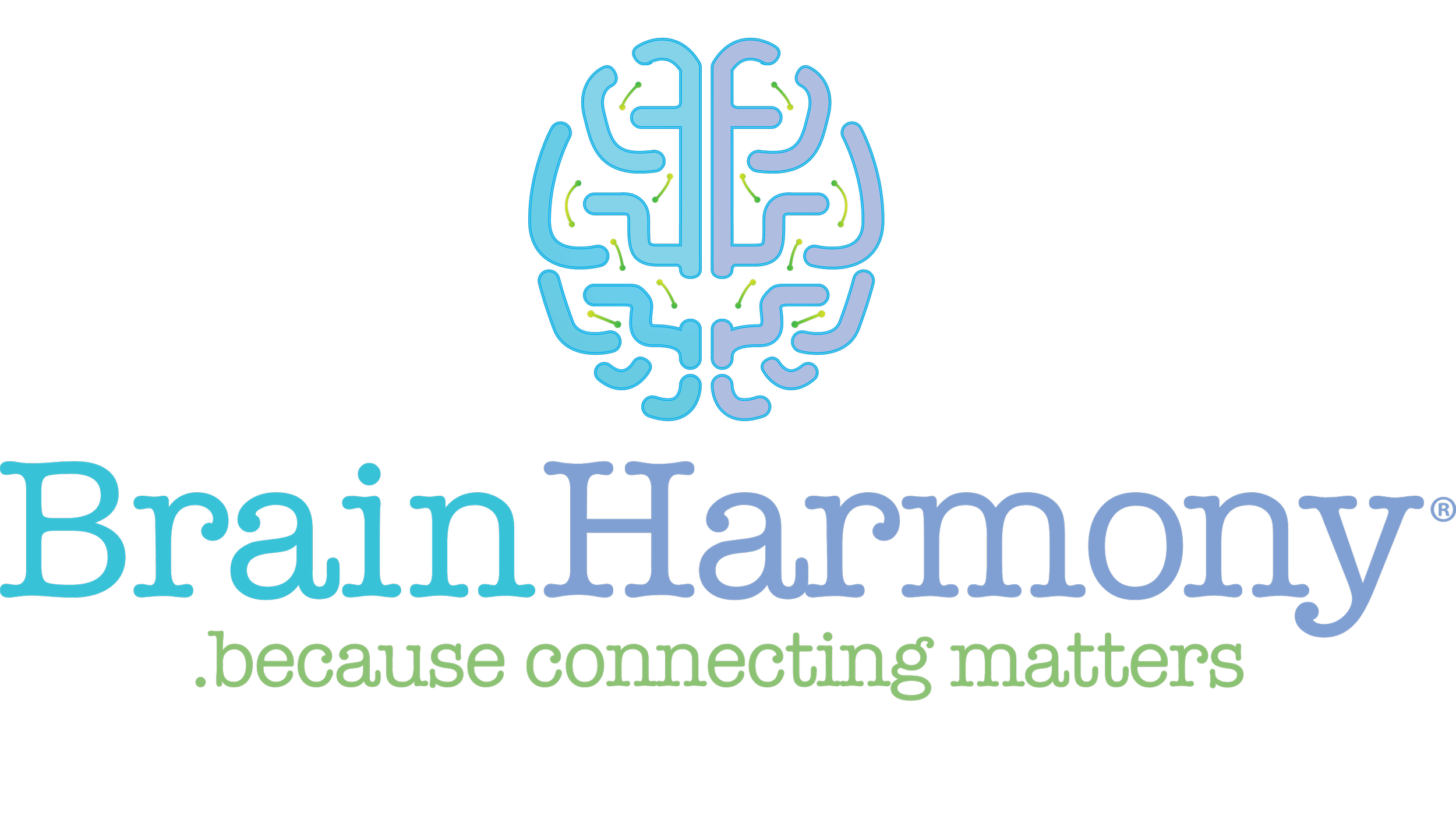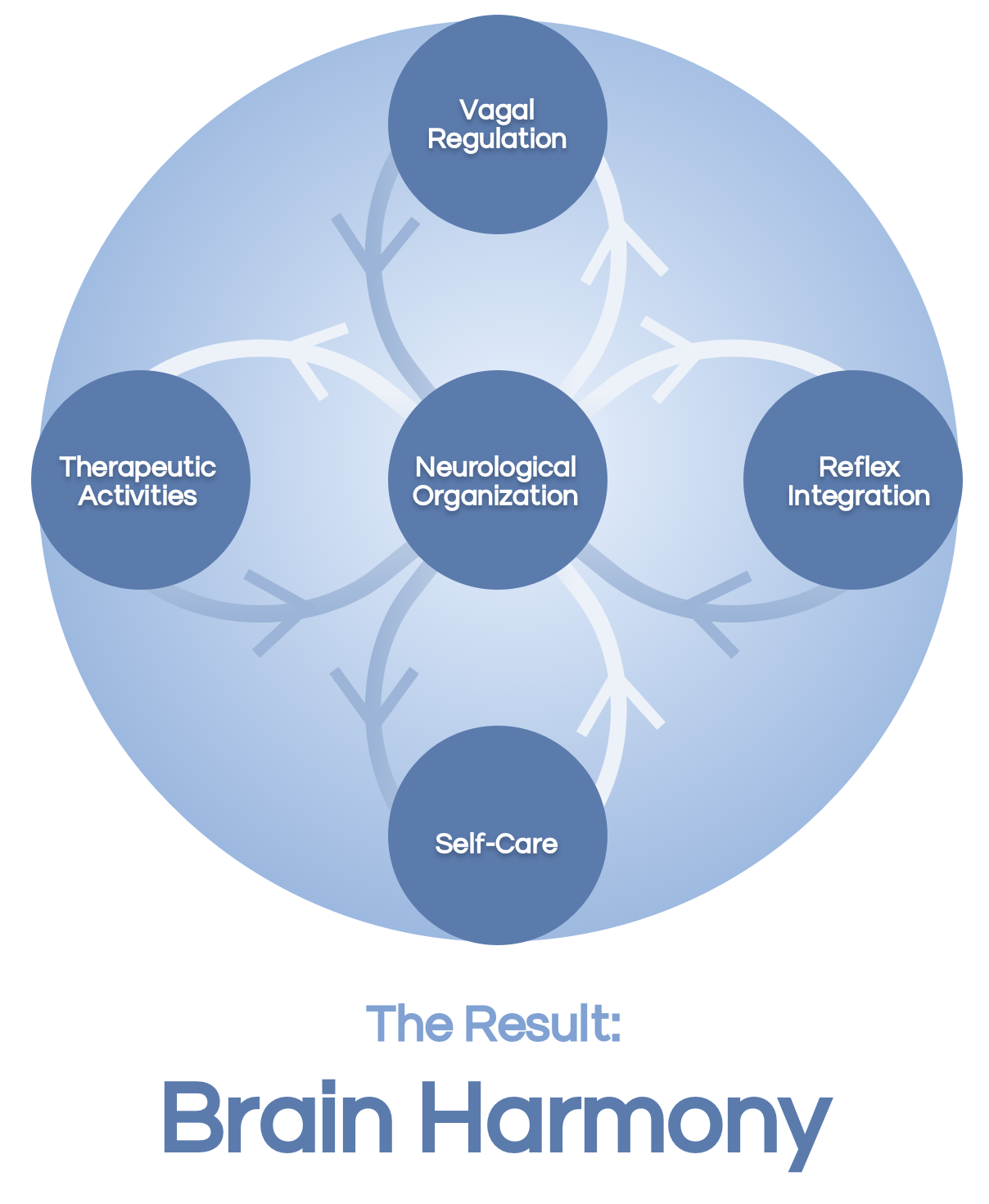What Makes Brain Harmony Different?
Our 5-Step Plan of Care
Our proprietary 5-Step Plan of Care is based on proven protocols, therapeutic activities, and occupational therapy with over 20 years and 250,000+ hours of combined clinical practice.
Most importantly, our 5-Step Plan of Care is completely tailored to your unique challenges, needs, and goals.
So you can get the personalized care you (or your child) needs to achieve the outcomes you need.
Here’s how it works:
Step 1: Vagal Regulation
Process:
In Step 1, we focus on calming down the nervous system. This is crucial. Because by reducing stress and calming the nervous system we’re preparing the brain for deep and lasting change.
Vagal regulation is the first step to achieving neurological calm. Over decades of clinical experience, we have refined our protocols to include the most powerful and easy-to-use interventions. We don’t rely on a “one-intervention-fits-all” approach. Instead, your occupational therapist will customize the interventions to include multiple resources and approaches.
Watch Video Testimonial:
Outcomes:
Adults can expect to feel more calm, relaxed, and resilient; enjoy deeper, more restorative sleep; improved communication; and a greater sense of self-confidence.
Children feel less anxious, less agitated by external stimuli, and more comfortable in social settings; sleep better; show improved articulation and increased pre-language skills; better ability to verbally communicate emotions and internal states; and improved ability to follow multi-step processes.
Most exciting of all, we typically see these outcomes within the first five days of treatment.
Video: Carol interviewing Mark
“The waves come through, but I let them pass by. I am neither in a hyper-state or in collapse which was my old state of existence. I have learned better practices and they are sticking. I am more able to follow through with my meditation. I’m realizing that stuff I thought was me is not me but more like a habituated response. It is bringing things up in my counseling sessions which are now more productive. As my body resets, I can clear things from my system, the trauma construct is dislodging. I am a witness to it.”
Step 2: Neurological Organization
Process:
In Step 2, we’ll use one or a combination of proven tools to improve brain function. We call this step “neurological organization” because it is literally the process of reorganizing the brain so it works for you instead of against you.
Unlike “old school” clinical approaches to therapy, this is a bottom-up process. Meaning: we address root causes instead of just symptoms.
What makes this step special is that the tools and treatment protocols we use are NOT one-size-fits all. They’re personalized to meet your unique challenges and goals.
Watch Video Testimonial:
Outcomes:
There is no program that is more effective or faster at achieving neurological organization. Although gains are unique to each individual, frequently experienced outcomes include:
Improved emotional control and regulation
Increased cognitive functioning
Access to ability to communicate verbally and non-verbally
Ability to access more words and communicate emotions and feelings
Establish intimacy with others
No longer needing pharmaceuticals to compensate for lack of attention or focus
Improved access to aptitude and potential
Greater self-confidence
Gained years worth of language, arts, and math skills (as measured by standardized assessments)
Step 3: Reflex Integration
Process:
If you hear a sudden loud noise, what happens? You’re startled. We’re born with many reflexes that help us survive and develop. Most of these reflexes are integrated by age three. But sometimes reflexes fail to integrate.
When that happens, it can cause physical, emotional, and behavioral challenges.
In Step 3, we screen for reflexes that haven’t fully integrated. We then train the caregiver in manual intervention strategies designed to integrate these reflexes.
Outcomes:
Reflex integration can help:
Improve physical coordination (walking, running, better sports performance, riding a bike, etc.)
Improve functional vision (ability to track a ball in air and keeping eyes on the page while reading)
Improve hearing (increased decoding of words and comprehension)
Improve focus, memory recall, thinking processes, emotional and behavioral regulation, and more.
Sharp increase in speech production with the use of hands and feet reflex patterns.
Age appropriate postural control
Age appropriate emotional regulation
Resolve sleep walking or night terrors
Step 4: Therapeutic Activities
Process:
In Step 4, we use therapeutic activities that incorporate balance, strength, and range of motion, to further organize the brain and improve functional activity.
What makes our process unique? Our 20+ years of providing occupational therapy to children and adults.
Because of that, we’ve evolved unique protocols that, when combined with our suite of tools, add and improve function.
It’s like downloading the commands for new, desired functions into your brain.
Watch Video Testimonial:
Outcomes:
Our Occupational Therapists specialize in connecting you with therapeutic activities that are intrinsically motivating for you or your family.
Measuring outcomes of participating in these therapeutic activities looks like this:
Mom created a visual schedule for her youngest daughter who struggles with independently completing her morning routine. By providing structure in her environment with a visual schedule, as well as structured repetition, her daughter developed the skills to complete her morning routine, without mom’s help.
A child who struggled and felt self-conscious in gym class is now able to participate thanks to improved physical performance and bilateral coordination.
An adult increased energy and resolved balance and vertigo issues via gardening, deep breathing, and light endurance training.
Step 5: Self-Care
Process:
Independence in self-care is what all parents want for their children, and it is the #1 skill adults want to preserve as we age. Being able to care for ourselves for intimate tasks like bathing, toileting and feeding is essential for true independence and self esteem.
In Step 5, we work with friends to break complex tasks into simple, digestible steps. We also work on frustration tolerance, coping skills, and more. This process is unique to the individual to ensure he or she develops meaningful, personalized self-care skills.
Outcomes:
If you pull back and take in the 30,000-foot view, the outcome is about empowering children and adults to live independent, self-guided lives.
By Step 5, our friends can expect to have new skills and tools to manage daily tasks and dramatically improve their quality of life.







